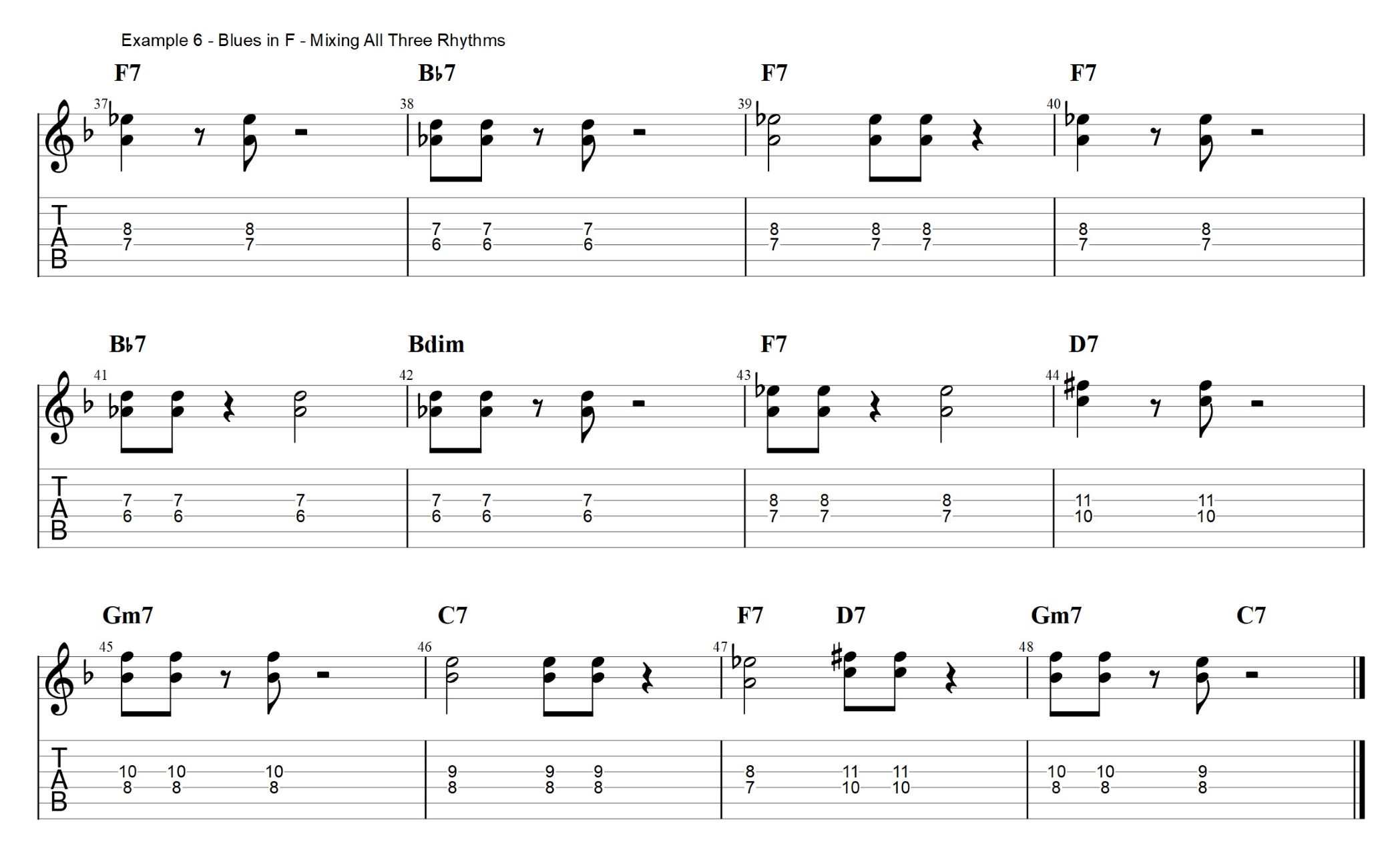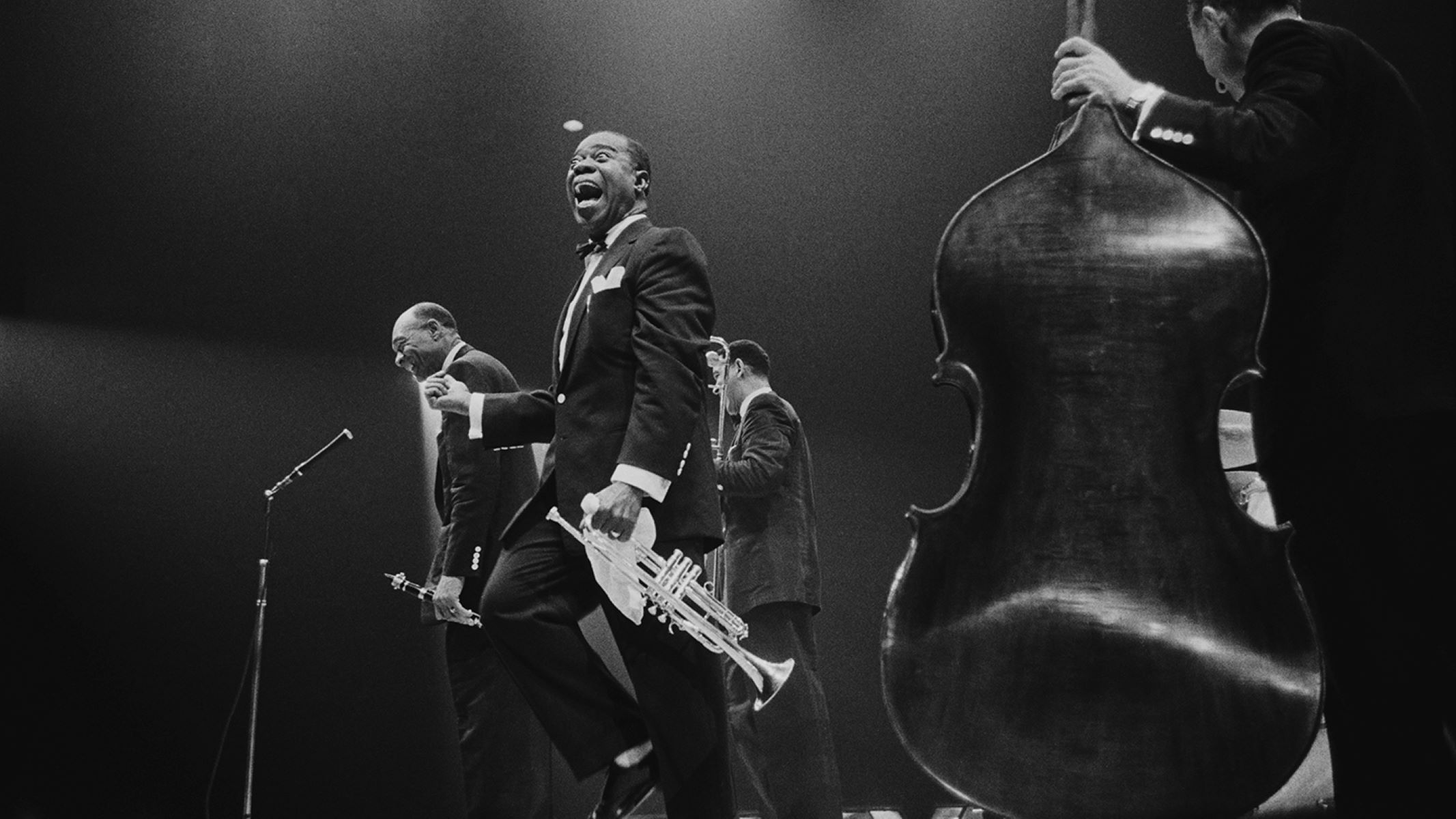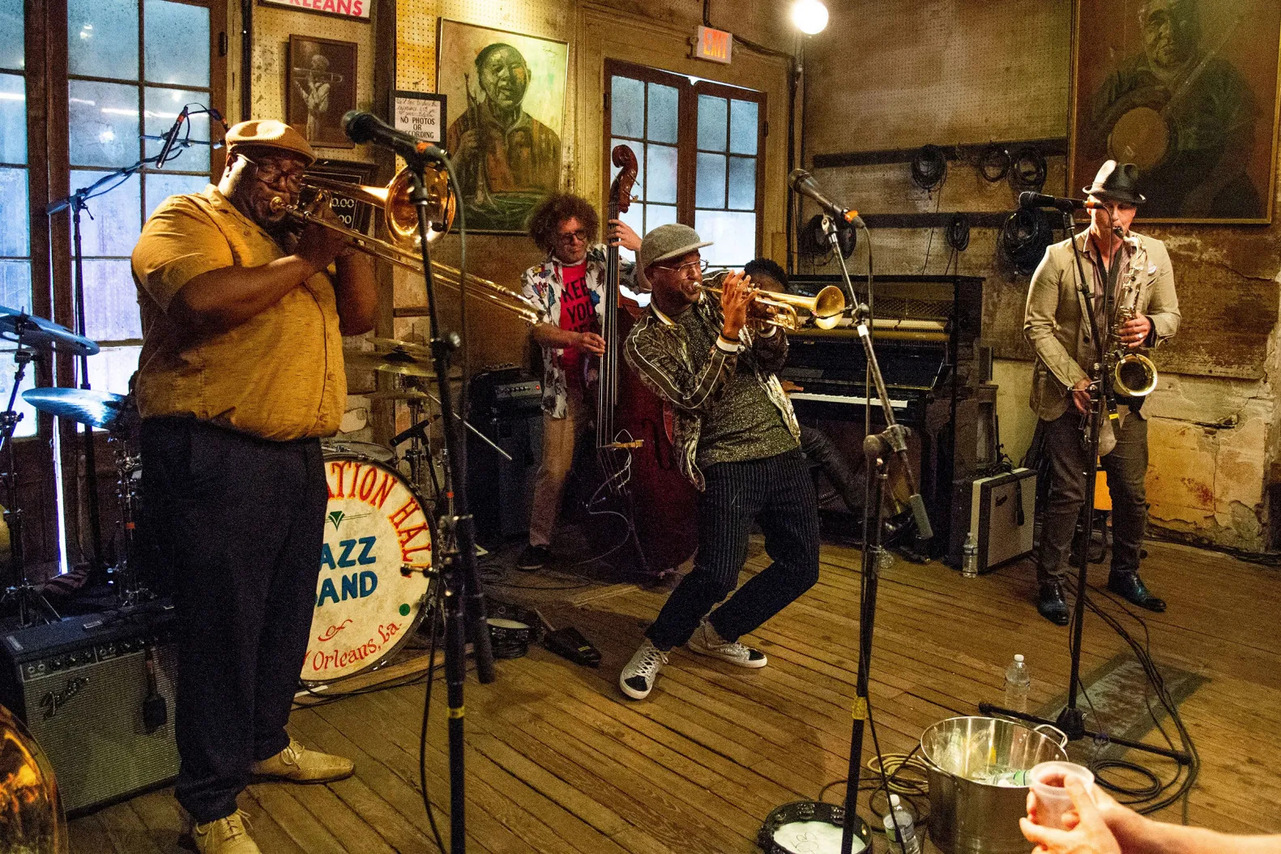

Jazz
What Is Jazz Guitar
Modified: February 15, 2024
Discover the art of jazz guitar and learn what makes it unique. Explore different techniques, scales, and improvisation styles that define the essence of jazz.
(Many of the links in this article redirect to a specific reviewed product. Your purchase of these products through affiliate links helps to generate commission for AudioLover.com, at no extra cost. Learn more)
Table of Contents
Introduction
Jazz guitar is a genre of music that has captivated audiences for decades with its soulful melodies, intricate harmonies, and improvisational nature. It is a genre that has its roots in African-American communities in the late 19th and early 20th centuries, and has evolved into a rich and diverse art form that continues to push musical boundaries.
Unlike other genres of guitar playing, such as rock or blues, jazz guitar is characterized by its emphasis on improvisation and complex chord progressions. Jazz guitarists are known for their ability to create unique and innovative melodies on the spot, often weaving intricate phrases and harmonies within the context of a song.
One of the defining features of jazz guitar is its versatility. Jazz guitarists are proficient in various styles ranging from traditional swing and bebop to more modern fusion and free jazz. This versatility allows them to adapt to different musical situations and collaborate with a wide range of musicians.
To master the art of jazz guitar, musicians must develop a strong foundation in music theory, as well as a deep understanding of chord voicings and scales. They also need to develop their ear for improvisation and learn to navigate complex harmonic structures.
In this article, we will explore the origins of jazz guitar, delve into the characteristics of jazz guitar playing, and highlight some of the techniques used by jazz guitarists. We will also discuss notable jazz guitarists who have made significant contributions to the genre, as well as famous jazz guitar standards that every aspiring jazz guitarist should know. Additionally, we’ll touch on the equipment and gear commonly used by jazz guitarists, and explore different jazz guitar styles.
Whether you are a guitar enthusiast looking to expand your musical horizons or a jazz aficionado eager to learn more about the instrument’s role in the genre, this article will serve as a comprehensive guide to jazz guitar. So sit back, relax, and let’s dive into the beautiful world of jazz guitar.
Origins of Jazz Guitar
To understand the origins of jazz guitar, we need to trace its roots back to the early days of jazz music itself. Jazz originated in the African-American communities in the southern United States during the late 19th and early 20th centuries. It was a musical genre born out of the fusion of African rhythms and European harmony.
In the early years of jazz, the guitar was not a prominent instrument. Brass instruments like the trumpet and saxophone took center stage, playing the melodies and improvising solos. However, with the development of the recording industry in the 1920s, the guitar began to make its mark.
The first notable jazz guitarist was Eddie Lang, who rose to prominence in the 1920s. He was known for his skillful fingerpicking technique and his ability to accompany other musicians with his rhythmic chordal playing. Lang’s playing paved the way for future jazz guitarists, and he became an influential figure in the jazz community.
During the 1930s and 1940s, the guitar took on a more prominent role in jazz music. Charlie Christian, an innovative guitarist, became a key figure in the development of the electric guitar as a solo instrument. His groundbreaking work with the Benny Goodman Orchestra showcased the guitar’s potential as a lead instrument in jazz.
Following Christian’s lead, other guitarists like Django Reinhardt and Wes Montgomery made significant contributions to the evolution of jazz guitar. Reinhardt, a Belgian-born musician of Romani descent, introduced a unique style of jazz guitar playing that combined his virtuosity on the instrument with elements of Gypsy jazz. Meanwhile, Montgomery brought a distinct melodic and rhythmic approach to jazz guitar, incorporating octaves and chord melodies into his playing.
In the 1950s and 1960s, jazz guitarists like Joe Pass and Jim Hall further expanded the possibilities of the instrument. Pass was renowned for his exceptional technical skills and his ability to play intricate solo arrangements. Hall, on the other hand, focused on creating a more introspective and melodic sound, often opting for a cleaner tone and minimalist approach.
As the genre continued to evolve, jazz guitarists in the latter half of the 20th century, such as Pat Metheny, John Scofield, and Kurt Rosenwinkel, brought their own unique styles and innovations to the art form. From fusion to avant-garde, these musicians pushed the boundaries of jazz guitar, incorporating elements from other genres and experimenting with new sounds and techniques.
Today, jazz guitar remains a vibrant and diverse genre, with countless guitarists continuing to explore its possibilities. The origins of jazz guitar may be rooted in the early days of jazz music, but its evolution and influence span generations, making it an essential component of the jazz genre as a whole.
Characteristics of Jazz Guitar
Jazz guitar is known for its distinct characteristics that set it apart from other genres of guitar playing. These characteristics contribute to the unique sound and style of jazz guitarists. Let’s explore some of the key elements that define jazz guitar:
1. Complex Chord Progressions: One of the defining features of jazz guitar is the use of complex chord progressions. Jazz musicians often incorporate extended chords, such as seventh, ninth, and thirteenth chords, into their playing. This creates a rich and harmonically sophisticated sound that adds depth to the music.
2. Improvisation: Improvisation is an essential aspect of jazz music, and jazz guitarists are known for their ability to spontaneously create melodies and harmonies on the spot. They navigate through chord changes, scales, and arpeggios, adding their unique flavors and ideas to the music. Improvisation allows jazz guitarists to express their creativity and individuality.
3. Swing Feel: Swing is a rhythmic style commonly associated with jazz. Jazz guitarists often incorporate a swinging feel into their playing, emphasizing syncopation and creating a sense of groove. This rhythmic style gives jazz music its infectious and lively energy.
4. Melodic Phrasing: Jazz guitarists are skilled in creating melodic and expressive phrases. They use techniques such as slides, bends, vibrato, and legato to add emotion and personality to their playing. These melodic lines often interact with the underlying chord progressions, creating tension and release within the music.
5. Comping: Comping, short for accompanying, is the art of playing chords behind other musicians, such as a vocalist or a soloist. Jazz guitarists excel at comping, providing supportive and rich harmonic foundations for the rest of the band. They use voicings and chord inversions to add color and texture to the music, complementing the melodies and solos.
6. Tone and Sound Exploration: Jazz guitarists are known for their quest for unique and interesting tones. They experiment with different pickup configurations, guitar amps, and effects pedals to achieve their desired sound. From warm and mellow to bright and cutting, jazz guitarists continually explore new sonic possibilities.
7. Collaboration and Interaction: Jazz is a highly collaborative genre, and jazz guitarists thrive on interacting with other musicians. They engage in musical conversations, trading solos, and responding to each other’s ideas. This interaction gives jazz performances a dynamic and spontaneous quality.
These characteristics are what make jazz guitar a captivating and ever-evolving art form. It requires technical proficiency, a deep understanding of music theory, and a passion for exploration and innovation. Jazz guitarists constantly refine their skills and push the boundaries of what the instrument can do, contributing to the rich tapestry of jazz music.
Techniques in Jazz Guitar Playing
Jazz guitar playing involves a wide range of techniques that allow guitarists to create unique sounds and express themselves within the context of a jazz ensemble. These techniques are essential for navigating complex chord progressions, improvising solos, and providing harmonic support. Let’s explore some of the key techniques used in jazz guitar playing:
1. Chord Voicings: Jazz guitarists employ various chord voicings to create interesting and harmonically rich accompaniments. These voicings often involve skipping certain chord tones or adding tension notes to create a unique sound. Common voicings include drop 2, drop 3, and rootless voicings, which allow guitarists to cover a wide range of chords and melodies.
2. Single-Note Lines: Jazz guitarists often play single-note lines, which are melodies played on one string or across multiple strings. These lines incorporate scales, arpeggios, and chromatic passing tones to create interesting and melodic phrases. Techniques such as legato, slides, and bends are used to add expressiveness and create a vocal-like quality.
3. Chord Melodies: Chord melodies involve playing both the melody and accompanying chords simultaneously on the guitar. This technique allows jazz guitarists to create a full and harmonically rich sound, even when playing solo. It requires intricate fingerpicking and careful coordination between the melody and the accompanying chords.
4. Improvisation: Improvisation is a core aspect of jazz guitar playing. It involves creating melodies, harmonies, and rhythmic patterns on the spot. Jazz guitarists use scales, arpeggios, and chord tones to navigate through chord progressions and respond to the music around them. They rely on their knowledge of music theory and ear training to create cohesive and inventive solos.
5. Tapping: Tapping is a technique where the guitarist uses both hands to produce notes on the fretboard. This technique allows for rapid and intricate playing, often incorporating various intervals and complex rhythms. Tapping can add a unique and percussive element to jazz guitar solos.
6. Hybrid Picking: Hybrid picking combines the use of a pick and fingers to pick and pluck the strings. This technique offers greater control and allows jazz guitarists to play intricate phrases with a combination of picked and finger-plucked notes. It enhances the dynamic range and flexibility of their playing.
7. Comping: Comping, as mentioned earlier, refers to accompanying other musicians by playing chord voicings. Jazz guitarists use comping techniques to provide harmonic support and rhythmic drive to the music. They incorporate rhythmic patterns, chord inversions, and voice leading to create a cohesive and exciting accompaniment.
These techniques, among others, form the foundation of jazz guitar playing. Mastering them requires dedication, practice, and a deep understanding of musical concepts. Jazz guitarists continually refine their technique to become more expressive and versatile in their playing, enriching the overall sound of jazz music.
Notable Jazz Guitarists
Throughout the history of jazz, numerous guitarists have made significant contributions to the genre, pushing the boundaries of what is possible on the instrument and inspiring generations of musicians. Here are some notable jazz guitarists who have left an indelible mark on the world of music:
1. Django Reinhardt: Often regarded as the father of Gypsy jazz, Django Reinhardt was a Belgian-born guitarist known for his innovative playing style and virtuosity. Despite being limited to just two functioning fingers on his left hand due to a fire accident, Reinhardt developed a unique technique that revolutionized jazz guitar playing.
2. Charlie Christian: A pioneer of the electric guitar, Charlie Christian played a vital role in popularizing the instrument as a lead voice in jazz. With his melodic improvisations and innovative use of amplification, he became an influential figure in the swing era, leaving a lasting impact on subsequent generations of jazz guitarists.
3. Wes Montgomery: Renowned for his distinctive octaves technique, Wes Montgomery created a rich and soulful sound on the guitar. His smooth and lyrical playing style, combined with his innovative use of thumb picking, made him one of the most influential jazz guitarists of all time.
4. Joe Pass: Joe Pass was celebrated for his exceptional solo playing and chordal improvisations. He was a master of chord melody, seamlessly blending chords and single-note lines to create a full, orchestral sound on the guitar. His virtuosity and harmonic knowledge continue to inspire aspiring jazz guitarists today.
5. Pat Metheny: With his unique blend of jazz, rock, and fusion, Pat Metheny has become one of the most successful and innovative jazz guitarists of the modern era. His melodic approach, use of advanced harmonies, and a distinctive tone have made him a recognizable and influential figure in contemporary jazz.
6. Jim Hall: Known for his introspective and nuanced playing style, Jim Hall was a highly influential jazz guitarist. His emphasis on melody, space, and interaction with other musicians made his playing thoughtful and engaging. Hall’s contributions to the genre continue to resonate with guitarists and jazz enthusiasts alike.
7. John Scofield: John Scofield is acclaimed for his versatility and ability to blend various genres seamlessly. His fusion of jazz, funk, and rock elements has earned him a wide audience and has cemented his status as one of the most innovative and influential jazz guitarists of his generation.
These are just a few of the many exceptional jazz guitarists who have left an indelible mark on the genre. Each guitarist has brought their unique style, sound, and innovation, contributing to the rich tapestry of jazz music and inspiring countless musicians to explore the boundaries of the instrument.
Famous Jazz Guitar Standards
Jazz guitarists have played a vital role in the creation and interpretation of countless jazz standards. These timeless compositions serve as a foundation for improvisation, allowing musicians to explore their creativity and showcase their skills. Here are some famous jazz guitar standards that every aspiring jazz guitarist should know:
1. “Autumn Leaves”: This classic jazz standard has been covered by numerous guitarists over the years. Its melancholic melody and iconic chord changes provide a perfect canvas for improvisation, making it a staple in the repertoire of jazz guitarists.
2. “All the Things You Are”: Another popular jazz standard, “All the Things You Are” features complex harmonies and a memorable melody. Its challenging chord progression and modulations offer a great opportunity for jazz guitarists to demonstrate their mastery of chord voicings and improvisation.
3. “Fly Me to the Moon”: Written by Bart Howard, this timeless tune has become a jazz standard. It features a catchy melody and straightforward chord changes, making it accessible for guitarists of all levels. Its popularity and versatility have led to numerous interpretations by jazz guitar legends.
4. “Summertime”: Composed by George Gershwin, “Summertime” has become one of the most frequently performed jazz standards. Its haunting melody and bluesy chord progression make it a favorite among jazz guitarists for improvisation and interpretation.
5. “Stella by Starlight”: This beautiful ballad composed by Victor Young has become a staple in the jazz guitar repertoire. Its intricate harmonies and emotional depth provide a perfect platform for expressive and lyrical guitar playing.
6. “My Favorite Things”: Written by Richard Rodgers and Oscar Hammerstein II for the musical “The Sound of Music,” this song has been reimagined in a jazz context. Jazz guitarists often explore its modal structure, allowing for explorative and innovative improvisation.
7. “Take the ‘A’ Train”: Composed by Billy Strayhorn, this swinging jazz composition is synonymous with the Duke Ellington Orchestra. The catchy melody and fast-paced chord changes keep the energy high, making it a beloved choice for jazz guitarists looking to showcase their technical prowess.
These are just a few examples of the many famous jazz guitar standards that have become cornerstones of the genre. Each tune presents unique challenges and opportunities for expression, inviting jazz guitarists to interpret them in their own personal style. Whether through chord melodies, single-note solos, or rhythmic comping, these standards provide a rich and diverse collection of material for aspiring jazz guitarists to explore and master.
Jazz Guitar Equipment and Gear
When it comes to jazz guitar, the right equipment and gear can greatly influence your sound and playing experience. Here are some essential pieces of equipment commonly used by jazz guitarists:
1. Guitar: The choice of guitar is crucial for jazz musicians. Most jazz guitarists opt for hollow-body or semi-hollow guitars, as these instruments produce warm and resonant tones that are well-suited for the genre. Popular choices include Gibson ES-175, Ibanez Artcore series, and Heritage H-535.
2. Amplifier: A quality amplifier is essential for reproducing the nuances of jazz guitar tones. Jazz guitarists typically favor tube amplifiers for their warm and responsive sound. Models like the Fender Deluxe Reverb, Roland JC-120, and Henriksen JazzAmp are popular choices among jazz guitarists.
3. Strings: Jazz guitarists often use heavier gauge strings for a fuller sound and improved projection. Flatwound strings, known for their smooth feel and warm tone, are particularly favored in jazz. Brands like D’Addario, Thomastik-Infeld, and La Bella offer popular options for jazz guitar strings.
4. Picks: Jazz guitarists typically use thicker picks for increased control and a fuller tone. Traditional jazz picks, commonly made of materials like celluloid or tortoiseshell, offer a warm and mellow sound. However, many guitarists now prefer picks made from synthetic materials such as nylon or Delrin for durability and consistency.
5. Effects Pedals: While jazz guitarists tend to rely more on their instrument and amplifier tone, some may use effects pedals to add versatility to their sound. Commonly used pedals include a reverb pedal for spaciousness, a compressor for leveling out dynamics, and an overdrive or boost pedal for a subtle touch of breakup when needed.
6. Guitar Straps and Stands: Comfortable and adjustable guitar straps are important for playing long sets or gigs. Guitar stands are also essential for keeping your instrument safe and easily accessible during rehearsals and performances.
7. Accessories: Additional accessories like a tuner, metronome, and guitar cables are essential for practice and live performances. A high-quality instrument cable ensures clear and reliable signal transmission between the guitar and amplifier.
It’s important to remember that the gear and equipment mentioned above are just recommendations, and personal preferences may vary. Ultimately, finding the right combination of equipment and gear that suits your playing style and sonic preferences is essential for achieving your desired jazz guitar sound.
Investing in quality instruments and gear can greatly enhance your playing experience and allow you to explore the full potential of jazz guitar. Experimenting with different combinations and settings can help you discover your unique voice as a jazz guitarist.
Jazz Guitar Styles
Jazz guitar is a versatile genre that encompasses a wide range of styles. From traditional swing to modern fusion, jazz guitarists have explored and contributed to various sub-genres within the broader scope of jazz. Here are some popular jazz guitar styles:
1. Swing: Swing is the foundation of jazz and was prominent in the big band era of the 1930s and 1940s. Jazz guitarists in the swing style often play rhythm guitar, providing a driving pulse with chordal accompaniment. They may also take melodic solos, using swing phrasing and incorporating bluesy elements.
2. Bebop: Bebop emerged in the 1940s as a reaction to the constraints of swing music. Bebop guitarists often employ fast and complex single-note lines, incorporating advanced harmonic concepts like substitutions and chromatic passing tones. Charlie Christian and Wes Montgomery were influential figures in the bebop style.
3. Cool Jazz: Cool jazz emerged in the late 1940s and 1950s, characterized by its more relaxed and laid-back sound. Cool jazz guitarists often use mellow tones, sparse phrasing, and melodic improvisation. Tal Farlow and Jim Hall were notable proponents of the cool jazz style.
4. Hard Bop: Hard bop developed in the 1950s and combined elements of bebop with blues and gospel influences. Hard bop guitarists often employ a more aggressive and bluesy approach, using soulful bends, fast lines, and extended blues vocabulary. Grant Green and Kenny Burrell were prominent figures in the hard bop style.
5. Fusion: Fusion emerged in the late 1960s, blending jazz with elements of rock, funk, and other genres. Fusion guitarists often use distortion, effects, and unconventional playing techniques to create a more electric and progressive sound. Pat Metheny and John Scofield are renowned for their contributions to fusion jazz guitar.
6. Latin Jazz: Latin jazz combines jazz with traditional Latin music styles, such as bossa nova, samba, and Afro-Cuban rhythms. Latin jazz guitarists incorporate these rhythmic elements and harmonies into their playing, often using nylon-string guitars to achieve a warmer and more percussive sound. Charlie Byrd and Antonio Carlos Jobim were influential in popularizing Latin jazz on the guitar.
7. Contemporary Jazz: Contemporary jazz is a broad term that encompasses different modern styles of jazz. In this style, guitarists often combine elements of traditional jazz with influences from various genres, including rock, funk, and world music. They may experiment with different guitar effects and explore unconventional harmonies and rhythms.
These are just a few examples of the diverse jazz guitar styles that have evolved over the years. Each style offers its own distinct characteristics and presents unique challenges and opportunities for improvisation and expression. Exploring and incorporating different styles is a hallmark of the jazz guitarist, allowing them to develop a versatile and personal approach to playing.
Conclusion
Jazz guitar is a captivating and ever-evolving genre that has left an indelible mark on the world of music. Its origins in African-American communities have led to a rich and diverse art form that continues to inspire and push boundaries.
Throughout the history of jazz, legendary guitarists have contributed to the development and evolution of the genre. Their innovative techniques, distinct playing styles, and expressive improvisations have shaped the sound of jazz guitar and influenced generations of musicians.
From the complex chord progressions and improvisational nature to the swinging rhythms and melodic phrasing, jazz guitar is characterized by its unique set of characteristics. Jazz guitarists excel at navigating intricate harmonies, creating captivating melodic lines, and providing harmonic support through comping.
Famous jazz guitar standards provide a rich repertoire for jazz guitarists to explore and showcase their skills. These timeless compositions serve as a foundation for improvisation and creativity, allowing guitarists to leave their personal mark on the music.
To achieve the desired jazz guitar sound, the choice of equipment and gear is essential. From hollow-body guitars and tube amplifiers to heavy gauge strings and thoughtful use of effects, jazz guitarists carefully select their tools to shape their tone and expressiveness.
Jazz guitar encompasses a variety of styles, from the swing era and bebop to cool jazz, fusion, and contemporary jazz. Each style presents unique challenges and opportunities for exploration, enabling guitarists to develop their signature sound and playing approach.
In conclusion, jazz guitar is a genre that continues to captivate audiences with its soulful melodies, complex harmonies, and improvisational nature. Whether you are a beginner starting your jazz guitar journey or an experienced player looking to further refine your skills, the world of jazz guitar offers a vast landscape to explore. Embrace the rich history, techniques, and styles, and let your creativity soar as you embark on the beautiful journey of jazz guitar.











